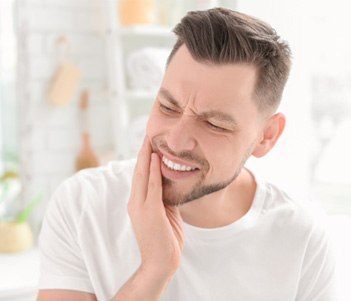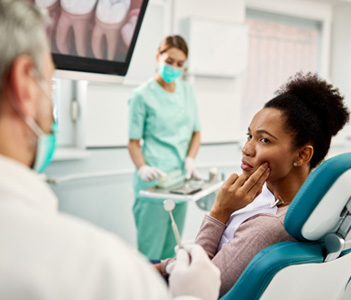
Tooth Extractions – Vero Beach, FL
The Last Resort for Badly Damaged Teeth

If your permanent teeth are lost, new ones won’t grow in their place. As such, when there’s an emergency, we always strive to repair your damaged teeth whenever possible. Sadly, some teeth are simply too far gone and can’t be salvaged no matter what steps are taken, leaving tooth extraction as the only option. The procedure is more comfortable than you might think; in fact, many of our patients say they don’t feel anything while it’s being performed! Find out if you need a tooth extraction by calling our office and scheduling an appointment with Dr. Adam or Dr. Giuliana.
Why Choose Premier Dental for Tooth Extractions?
- Sedation for Reducing Dental Anxiety
- Same-Day Emergency Appointments
- Advanced Training and Technology
Reasons Why Tooth Extractions Are Necessary

A tooth extraction may be unavoidable in the following situations:
- One of your teeth has a very large cavity, and the remaining dental structure isn’t strong enough for a crown.
- There’s an advanced infection that might affect the rest of your mouth if the tooth isn’t removed.
- Your teeth are loose due to untreated gum disease.
- You are planning on getting dentures, but some of the teeth that need to be replaced are still in your mouth.
The Process of Removing a Tooth

If you ask what the extraction process will look like, the answer will depend on whether you’re undergoing a simple extraction or a surgical one.
A simple extraction is carried out with forceps and an instrument called an elevator. After the tooth has been loosened, it is slowly wiggled back and forth until it slips out of the mouth. You can usually get a simple extraction if the problematic tooth has completely erupted and can be seen above the gums.
On the other hand, certain teeth – such as those that never break through the gums – might need to be extracted surgically. In cases where a tooth proves especially hard to remove, it might be divided into two or more pieces first.
Before any type of extraction is performed, your mouth will need to be numbed with a local anesthetic. It may also sometimes be necessary to use a form of dental sedation to keep you in a calm, relaxed state during the procedure.
Tooth Extraction Aftercare

After your extraction, a blood clot will form over the socket. Said blood clot plays a vital role in the healing process, so make sure you keep it safe by not doing anything that could dislodge it. (Examples include smoking, spitting, and drinking through a straw.)
Here are a few other things you can do to take care of your smile after an extraction:
- Sleep with an extra pillow in order to keep your head elevated.
- Only eat soft or liquid foods. Do not try to bite or chew hard foods, as doing so could lead to bleeding.
- Keep swelling down by applying a cold pack to the area for 15 minutes at a time.
Understanding the Cost of Tooth Extractions

Most patients have concerns regarding finances when it comes to dental care, and when trying to determine the cost of tooth extractions yourself, things can be a little confusing, given how many factors are in play. However, while we can’t give you an exact estimate, what we can do is give you a better idea about what you can expect to pay when you come in for your initial appointment. We’ll also work with you to make sure you’re making your care as affordable as possible. Continue reading below to learn a little more about what goes into the cost of tooth extractions in Vero Beach.

Factors That Can Affect Tooth Extraction Cost
No two tooth extractions are ever going to be exactly the same, meaning the cost will vary from patient to patient. During your appointment, we’ll be able to inspect your mouth and determine if tooth extraction is the best option, and from there, we can begin reviewing the expected cost. This usually depends on different factors like:
- The location of the tooth (back teeth are usually more difficult to extract compared to front teeth)
- The total number of teeth that need to be removed
- The method of extraction that’s being utilized (simple vs. surgical)
- Whether the tooth has partially or fully erupted
- The type of anesthesia/sedation that is used

Does Dental Insurance Cover Tooth Extractions?
Since tooth extraction is usually performed for the sake of the patient’s oral health, it’s common for many dental insurance plans to offer some level of coverage – even as much as 50% in some cases. However, it’s wise to be aware of your unique plan’s details, as there still could be certain limits, waiting periods, or restrictions. In any case, our team is happy to review the details of your plan with you to ensure that whatever benefits you have are being used effectively.

How to Make Tooth Extractions Affordable
Patients who lack dental insurance aren’t entirely out of luck when it comes to affording their tooth extraction procedure. Our office is thrilled to partner with third-party financers like CareCredit, who allow qualifying patients to break up the overall cost of their treatment with the help of one of several low-interest, flexible plans. Our office also proudly offers an in-house savings plan to our patients that can help them afford the care they need without any financial stress. If you have any questions, don’t hesitate to reach out to our team!
Tooth Extractions FAQs
Does Getting a Tooth Extracted Hurt?
You don’t have to worry; you won’t feel any pain while we work to gently, carefully, and safely remove your tooth. Remember, the first step of the treatment process is the same whether we’re removing one tooth or several: numbing your mouth! Plus, we will provide you with aftercare instructions to ensure you stay comfortable during the healing process, like avoiding crunchy foods, taking OTC pain medication as directed, and steering clear of hot beverages.
Can I Leave the Space Empty After a Tooth Extraction?
That depends largely on the reason your tooth is being extracted. For example, if we’re extracting it to make room in your mouth prior to orthodontic treatment, then that defeats the purpose of the procedure. If, on the other hand, your tooth was removed due to serious decay or damage, then we will need to replace it to restore the look, health, and function of your smile.
What Are My Options for Replacing a Missing Tooth?
At our Vero Beach dental office, we offer dental bridges, dentures, and dental implants. We will review each of these options more in-depth at your consultation (once we determine how many teeth need to be replaced, the density of your jawbone, and your commitment to good oral hygiene best practices). With all of that said, dental implants are highly sought-after because of their unique benefits, including the fact that they replace both the root and crown of the missing tooth.
Can I Smoke After Getting a Tooth Extracted?
It’s important that you don’t use any tobacco products, including e-cigarettes, both leading up to and after your tooth extraction. There are a few reasons for this, including that smoking can delay healing and lead to a dry socket. So, quit for at least two weeks after your procedure.
What Can I Do to Speed Up the Healing Time?
Technically, there isn’t a way to speed up the healing time. Of course, there are ways you can prolong it, which isn’t ideal. The best thing to do is follow all of the aftercare instructions we provide you – from avoiding strenuous exercise and eating soft foods to using a cold compress for 10 minutes at a time and taking OTC pain medication as directed. If you notice that your symptoms are getting worse instead of better after the 3-day mark, then schedule a follow-up appointment with us so we can make sure an infection hasn’t developed.